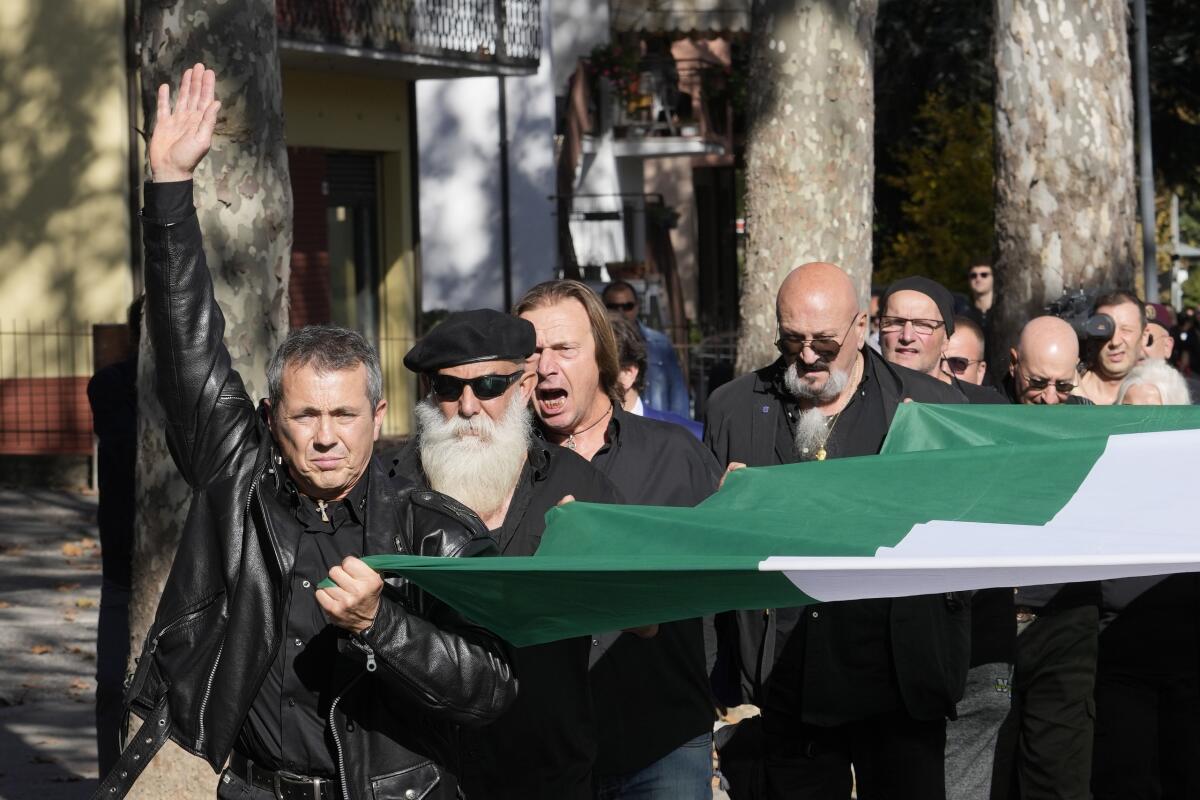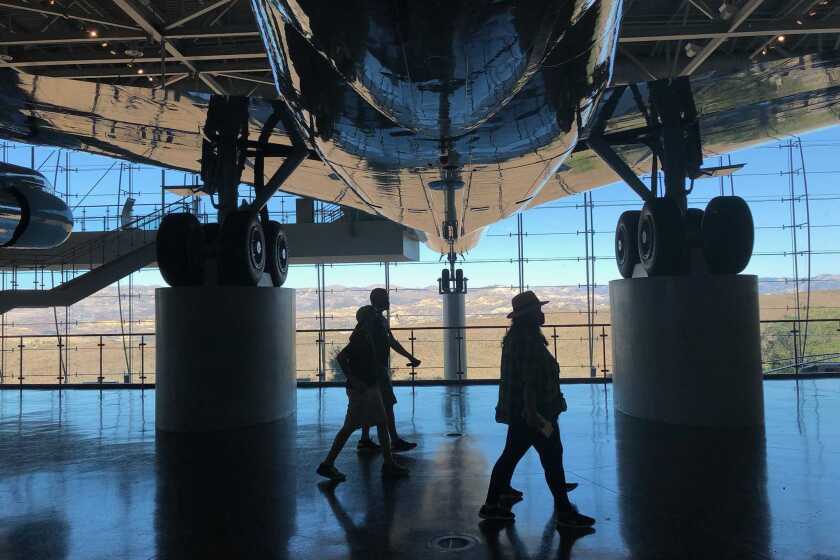Thousands commemorate Italy’s fascist dictator Mussolini

- Share via
PREDAPPIO, Italy — Several thousand black-clad fascist sympathizers chanted and sang in praise of Benito Mussolini as they marched to the slain Italian dictator’s crypt Sunday, 100 years after Mussolini entered Rome and completed a bloodless coup that gave rise to two decades of fascist rule.
The crowd of some 2,000 to 4,000 marchers, many sporting fascist symbols and singing hymns from Italy’s colonial era, was more numerous than in the recent past, as the fascist nostalgics celebrated the centenary of the March on Rome. On Oct 28, 1922, black-shirted fascists entered the Italian capital, launching a putsch that culminated two days later when Italy’s king handed Mussolini the mandate to start a new government.
The crowd in Predappio, Mussolini’s birth and final resting place in the northern Emilia-Romagna region, also was apparently emboldened by the fact that a party with neo-fascist roots is heading an Italian government for the first time since World War II.
Organizers warned participants, who arrived from as far away as Rome, Belgium and the United States, not to flash the Roman salute used by the fascists, or they would risk prosecution. Still, some couldn’t resist as the crowd stopped outside of the cemetery where Mussolini is laid to rest for prayers and greetings from Mussolini’s great-granddaughter, Orsola.
“After 100 years, we are still here to pay homage to the man this state wanted, and who we will never stop admiring,” Orsola Mussolini said to cheers.
With the midterm election looming, these California voters fear U.S. democracy is beyond repair, and blame politicians for feeding the dysfunction.
She listed her great-grandfather’s accomplishments, citing an infrastructure boom that built schools, hospitals and public buildings, the reclaiming of malaria-infested swamps for cities, and the extension of a pension system to nongovernment workers. She was joined by her sister Vittoria, who led the crowd in a prayer.
The crowd gave a final shout of “Duce, Duce, Duce,” Mussolini’s honorific as Italy’s dictator.
Anti-fascist campaigners held a march in Predappio on Friday, to mark the anniversary of the liberation of the town — and to prevent the fascists marching on the exact anniversary of the March on Rome.
Inside the cemetery Sunday, admirers of the Duce lined up to enter his crypt tucked in a back corner, a handful at a time. Each was given a memory card signed by his great-granddaughters with a photo of a smiling Mussolini holding his leather-gloved hand high in a Roman salute. “History will prove me right,” the card reads.
Italy’s failure to fully come to terms with its fascist past has never been more stark than now, as the nation’s new premier, Giorgia Meloni, seeks to distance her far-right Brothers of Italy party from its neo-fascist roots. Last week, she decried fascism’s antidemocratic nature and called its racial laws, which sent thousands of Italian Jews to Nazi death camps, “a low point.” Historians would also add Mussolini’s alliance with Nazi Germany and Japan in World War II and his disastrous colonial campaign in Africa to its devastating legacies.
Now in power, Meloni is seeking a moderate course for a new center-right government including Matteo Salvini’s League and Silvio Berlusconi’s Forza Italia. But her victory gives far-right activists a sense of vindication even if they see themselves even further to the right.
“I would have voted for Lucifer if he could beat the left,” said organizer Mirko Santarelli, who heads the Ravenna chapter of the Arditi, an organization that began as a World War I veterans group and has evolved to include caretaking Mussolini’s memory. “I am happy there is a Meloni government, because if there is nothing worse than the Italian left. It is not the government that reflects my ideas, but it is better than nothing.”
He said he would like to see the new government do away with the laws that prosecute incitement to hatred and violence motivated by race, ethnicity, religion and nationality. It includes use of emblems and symbols — many of which were present in Sunday’s march.
Santarelli said the law punishes “the crime of opinion.”
“It is used as castor oil by the left to make us keep quiet. When I am asked my opinion of Mussolini, and it is clear I speak well of him, I risk being denounced,” Santarelli said.
Lawyer Francesco Munitillo, a far-right activist who represents the organizers, said Italy’s high court established that manifestations are permissible as long as they are commemorative “and don’t meet the criteria that risks the reconstitution of the fascist party.”
Still, he said, magistrates in recent years have opened investigations into similar manifestations in Predappio and elsewhere to make sure they don’t violate the law. One such case was closed without charges this month.
Santarelli asked the rank and file present not to speak to journalists. Most complied.
Rachele Massimi traveled with a group four hours from Rome on Sunday to participate in the event, bringing her 3-year-old, who watched the march from a stroller.
“It’s historic,” Massimi said. “It’s a memory.”
More to Read
Sign up for Essential California
The most important California stories and recommendations in your inbox every morning.
You may occasionally receive promotional content from the Los Angeles Times.











